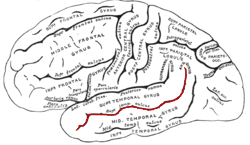Superior temporal sulcus
| Superior temporal sulcus | |
|---|---|
 | |
 | |
| Details | |
| Part of | Temporal lobe |
| Identifiers | |
| Latin | sulcus temporalis superior |
| TA | A14.1.09.145 |
| FMA | 83783 |
The superior temporal sulcus is the sulcus separating the superior temporal gyrus from the middle temporal gyrus in the temporal lobe of the brain. The superior temporal sulcus is the first sulcus inferior to the lateral fissure.
Recent studies reveal multisensory processing capabilities.[1] Research has documented activation in the STS as a result of five specific social inputs, and thus the STS is assumed to be implicated in social perception. It showed increased activation related to: voices versus environmental sounds, stories versus nonsense speech, moving faces versus moving objects, biological motion,[2] and theory of mind (false belief stories versus false physical stories).[3] It is involved in the perception of where others are gazing (joint attention) and is thus important in determining where others' emotions are being directed.[4]
In individuals without autism, the superior temporal sulcus also activates when hearing human voices.[5] It is thought to be a source of sensory encoding linked to motor output through the superior parietal-temporal areas of the brain inferred from the time course of activation. The conclusion of pertinence to vocal processing can be drawn from data showing that the regions of the STS (superior temporal sulcus) are more active when people are listening to vocal sounds rather than non-vocal environmentally based sounds and corresponding control sounds, which can be scrambled or modulated voices.[6] These experimental results indicate the involvement of the STS in the areas of speech and language recognition.
The majority of studies find it is the middle to the posterior portion of the STS that is involved in phonological processing, with bilateral activation indicated though including a mild left hemisphere bias due to greater observed activation. However, the role of the anterior STS in the ventral pathway of speech comprehension and production has not been ruled out.[7] Evidence for the involvement of the middle portion of the STS in phonological processing comes from repetition-suppression studies, which use fMRI to pinpoint areas of the brain responsible for specialized stimulus involvement by habituating the brain to the stimulus and recording differences in stimulation response. The resultin g pattern showed expected results in the middle portion of the STS.[8]
According to the audiological pathway model supplied by Hickok and Poeppel, after the spectrotemporal analysis conducted by the auditory cortex, the STS is responsible for interpretation of vocal input through the phonological network. This implication is shown in the activation of the region in tasks of speech perception and processing, which necessarily involves access to and continuance of phonological information. By manipulating the interactions of phonological data, represented by the provision of words with high or low neighborhood density (words associated with many or few other words), the fluctuation of activity of the STS region can be seen. This changing activation links the STS with the phonological pathway.[7]
Various disorders of the STS have been documented in which patients fail to recognize a certain stimulus, but still exhibit subcortical processing of the stimulus, this is known as an agnosia. Pure auditory agnosia (agnosia without aphasia) is found in a patients who can't identify non-speech sounds such as coughing, whistling, and crying but have no deficit in speech comprehension. Speech agnosia is known as an incapability to comprehend spoken words despite intact hearing, speech production, and reading ability. Patients show an recognition of the familiarity of a word, but are not able to recall its meaning. Phonagnosia is characterized as an inability to recognize familiar voices, while having other auditory abilities. Patients exhibited a double dissociation with either an inability to match names or faces with a certain famous voice, or to discriminate familiar voices from unfamiliar ones. Visual agnosia can be broken into separate disorders in regards to what is being recognized.[9] An inability to recognize written words is known as alexia or word blindness, while an inability to recognize familiar faces is known as prosopagnosia. Prosopagnosia has been shown to have a similar double dissociation as phonagnosia in that some patients show an impairment of memory for familiar faces while others show impairment when discriminating familiar faces from unfamiliar ones.
References
- ↑ Senkowski, D., Schneider, T. R., Foxe, J. J., & Engel, A. K. (2008).
- ↑ Grossman, E. D.; Blake, R. (2001). "Brain activity evoked by inverted and imagined biological motion". Vision Research. 41: 1475–1482. doi:10.1016/s0042-6989(00)00317-5.
- ↑ Beauchamp, Michael (September 2015). "The social mysteries of the superior temporal sulcus". Cell Press.
- ↑ Campbell, R.; Heywood, C.A.; Cowey, A.; Regard, M.; Landis, T. (1990). "Sensitivity to eye gaze in prosopagnosic patients and monkeys with superior temporal sulcus ablation". Neuropsychologia. 28 (11): 1123–1142. doi:10.1016/0028-3932(90)90050-x.
- ↑ Carter, Rita. The Human Brain Book. p. 241.
- ↑ Belin, P.; Zatorre, R. J.; Lafaille, P.; Ahad, P.; Pike, B. (2000-01-20). "Voice-selective areas in human auditory cortex". Nature. 403 (6767): 309–312. doi:10.1038/35002078. ISSN 0028-0836. PMID 10659849.
- 1 2 Hickok, Gregory; Poeppel, David (2007-05-01). "The cortical organization of speech processing". Nature Reviews Neuroscience. 8 (5): 393–402. doi:10.1038/nrn2113. ISSN 1471-003X.
- ↑ Vaden Jr., Kenneth I.; Muftuler, L. Tugan; Hickok, Gregory (2010-01-01). "Phonological repetition-suppression in bilateral superior temporal sulci". NeuroImage. 49 (1): 1018–1023. doi:10.1016/j.neuroimage.2009.07.063. PMC 2764799
 . PMID 19651222.
. PMID 19651222. - ↑ Van Lancker, D. R.; Canter, G. J. (1982-04-01). "Impairment of voice and face recognition in patients with hemispheric damage". Brain and Cognition. 1 (2): 185–195. doi:10.1016/0278-2626(82)90016-1. ISSN 0278-2626. PMID 6927560.
| Wikimedia Commons has media related to Superior temporal sulcus. |